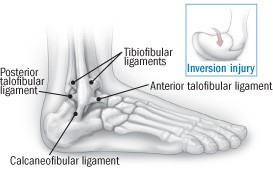A simple misstep is often all it takes to find yourself with a sprained ankle. It’s a remarkably common injury, affecting people from all walks of life, whether you’re an athlete pushing your limits or someone enjoying a relaxed day at home. An ankle sprain occurs when the tough bands of tissue called ligaments, which support your ankle joint, are stretched or torn. This damage leads to pain, swelling, and makes walking a challenge. While some might try to ignore the discomfort, understanding the severity of an ankle sprain and seeking appropriate care is crucial for proper healing and preventing future problems. Neglecting a more serious sprain can lead to incomplete recovery, reduced ankle mobility and stability, and a higher risk of recurrent sprains down the line.
Understanding Ankle Sprain Anatomy
The most frequent type of ankle sprain is known as an inversion injury, or a lateral ankle sprain. This happens when your foot rolls inward, impacting the ligaments on the outer side of your ankle. These key ligaments include the anterior talofibular ligament, the calcaneofibular ligament, and the posterior talofibular ligament. Ligaments are essential connective tissues that link bones together, providing stability to joints.
| ### Ankle ligaments |
 |
| Diagram illustrating the ligaments of the ankle joint |
Sprains can also occur on the inner ankle (medial ankle sprains), though these are less common. Another type, syndesmotic sprains, involves injury to the tibiofibular ligaments. These ligaments connect the tibia and fibula, the two bones in your lower leg, just above the ankle. Syndesmotic sprains are often seen in contact sports and have a higher likelihood of causing long-term ankle instability and repeated sprains if not properly managed.
The severity of an ankle sprain is graded based on the extent of ligament damage and the resulting instability of the ankle joint. The more severe the sprain, naturally, the longer it will take to heal.
| ### Grades of ankle sprain severity |
How Long Does a Sprained Ankle Take to Heal?
The healing time for a sprained ankle varies significantly depending on the severity of the injury. As illustrated in the table above, recovery can range from a few weeks to several months.
- Grade 1 Sprain: Typically heals within 1 to 3 weeks. These are mild sprains with minimal ligament stretching.
- Grade 2 Sprain: Expect a recovery period of 3 to 6 weeks. These sprains involve partial ligament tears.
- Grade 3 Sprain: Healing can take several months or longer. These are severe sprains with complete ligament tears or ruptures.
It’s important to remember that these are estimated timelines. Individual healing can be influenced by factors such as age, overall health, and adherence to treatment and rehabilitation plans. Proper management and rehabilitation are key to minimizing recovery time and ensuring a full return to function.
Treating a Sprained Ankle: The RICE Method and Beyond
The initial focus of ankle sprain treatment is to reduce pain and swelling and to protect the injured ligaments from further damage. The cornerstone of early treatment is the RICE regimen:
- Rest: Minimize weight-bearing on the injured ankle as much as possible, especially in the first 24 to 48 hours.
- Ice: Apply ice packs to the ankle for 15 to 20 minutes at a time, three times a day, or until swelling begins to decrease. Always use a towel between the ice pack and your skin to prevent ice burn. Cold therapy helps reduce pain and inflammation.
- Compression: Use an elastic bandage, such as an ACE wrap or an elastic ankle sleeve, to compress the ankle and help control swelling. Ensure the wrap is snug but not too tight, as it should not cut off circulation.
- Elevation: When sitting or resting, elevate your ankle above your heart level, ideally to the height of your hip. Elevation also helps reduce swelling by promoting fluid drainage.
In the first 24 hours after injury, avoid anything that could increase swelling, such as hot showers, hot packs, or heat rubs. These can worsen inflammation in the acute phase.
When to Seek Medical Advice for a Sprained Ankle
While many minor ankle sprains can be managed at home, it’s important to know when to consult a healthcare professional. If you experience any of the following, seek medical attention:
- Severe pain and swelling: If the pain is intense and swelling is significant, it may indicate a more severe sprain or even a fracture.
- Inability to bear weight: If you cannot put weight on your injured ankle or take more than a few steps without significant pain, it’s important to get it checked.
- Numbness or tingling: These sensations could indicate nerve involvement or circulatory issues.
- Visible deformity: If your ankle looks misshapen, it could be a sign of a fracture or dislocation.
- Symptoms not improving: If your symptoms don’t start to improve within a few days of home treatment with RICE, seek medical advice.
A clinician will examine your ankle and foot, and may manipulate them to assess the type and severity of the sprain. This examination might be delayed until some of the initial swelling and pain subside. Continue with the RICE protocol while waiting for your appointment.
X-rays are not routinely needed for ankle sprains because they primarily visualize bones, not ligaments. However, to rule out a fracture, clinicians may use the Ottawa ankle rules. These are a set of guidelines that help identify patients who are more likely to have a fracture based on pain, tenderness, and inability to bear weight in specific areas of the foot and ankle. Studies have shown the Ottawa rules to be highly effective in identifying ankle fractures.
Strengthening Your Ankle After a Sprain: Restoring Function
Full recovery from an ankle sprain requires not only pain and swelling reduction but also restoring the ankle joint’s normal range of motion and strengthening the ligaments and surrounding muscles. Research supports the benefits of functional treatment, which emphasizes early motion and weight-bearing as tolerated, often with support like splints, braces, tape, or elastic bandages. This approach has been shown to facilitate a quicker return to normal activities compared to immobilization methods like plaster casts.
Functional treatment typically involves three phases:
- Initial Phase (24-48 hours): RICE regimen to control pain, swelling, and prevent further injury.
- Range-of-Motion and Strengthening Phase (48-72 hours onwards): Begin gentle exercises to restore movement and strength.
- Endurance and Balance Training Phase (later recovery): Focus on activities to improve stability and prevent re-injury as healing progresses.
You can generally start range-of-motion and stretching exercises within the first 48 hours, and continue them until you are pain-free. Begin exercises while seated, and as your ankle improves, progress to standing exercises. If you don’t see improvement in your symptoms within two to four weeks, consulting a physical therapist or sports medicine specialist is recommended.
